Antenna Types – Array Antenna
February 3, 2019
Antenna Types – Array Antenna

VHF collinear array of folded dipoles
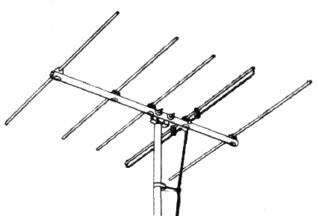
Yagi-Uda television antenna for analog channels 2-4, 47-68 MHz
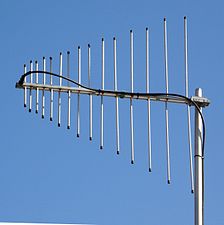
Log-periodic dipole array covering 140-470 MHz
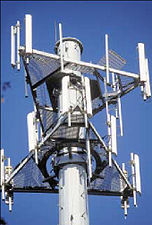
Sector antennas (white bars) on cell phone tower. Collinear arrays of dipoles, these radiate a flat, fan-shaped beam.
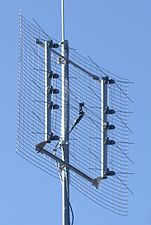
Reflective array UHF TV antenna, with bowtie dipoles to cover the UHF 470-890 MHz band
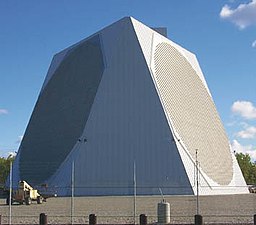
US Air Force PAVE PAWS phased array radar antenna for ballistic missile detection, Alaska. The two circular arrays are each composed of 2677 crossed dipole antennas.
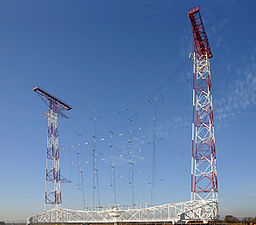
Curtain array shortwave transmitting antenna, Austria. Wire dipoles suspended between towers
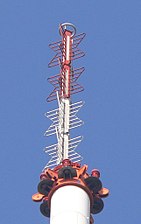
Four-bay batwing television broadcasting antenna, Germany.
Array antennas consist of multiple simple antennas working together as a single compound antenna. Broadside arrays consist of multiple identical driven elements, usually dipoles, fed in phase, radiating a beam perpendicular to the antenna plane. Endfire arrays are fed out-of-phase, with the phase difference corresponding to the distance between them; they radiate within the antenna plane. Parasitic arrays consist of multiple antennas, usually dipoles, with one driven element and the rest parasitic elements, which radiate a beam along the line of the antennas.
Collinear – Consist of a number of dipoles in a vertical line. It is a high-gain omnidirectional antenna, meaning more of the power is radiated in horizontal directions and less wasted radiating up into the sky or down onto the ground. Gain of 8–10 dBi. Used as base station antennas for land mobile radio systems such as police, fire, ambulance, and taxi dispatchers, and sector antennas for cellular base stations.
Yagi-Uda – One of the most common directional antennas at HF, VHF, and UHF frequencies. Consists of multiple half-wave dipole elements in a line, with a single driven element and multiple parasitic elements which serve to create a uni-directional or beam antenna. These typically have gains between 10–20 dBi depending on the number of elements used, and are very narrow band (with a usable bandwidth of only a few percent) though there are derivative designs which relax this limitation. Used for rooftop television antennas, point-to-point communication links, and long distance shortwave communication using skywave (“skip”) reflection from the ionosphere.
Log-periodic dipole array – Often confused with the Yagi-Uda, this consists of many dipole elements along a boom with gradually increasing lengths, all connected to the transmission line with alternating polarity. It is a directional antenna with a wide bandwidth. This makes it ideal for use as a rooftop television antenna, although its gain is much less than a Yagi of comparable size.
Reflective array – Multiple dipoles in a two-dimensional array mounted in front of a flat reflecting screen. Used for radar and UHF television transmitting and receiving antennas.
Phased array – A high gain antenna used at UHF and microwave frequencies which is electronically steerable. It consists of multiple dipoles in a two-dimensional array, each fed through an electronic phase shifter, with the phase shifters controlled by a computer control system. The beam can be instantly pointed in any direction over a wide angle in front of the antenna. Used for military radar and jamming systems.
Curtain array – Large directional wire transmitting antenna used at HF by shortwave broadcasting stations. It consists of a vertical rectangular array of wire dipoles suspended in front of a flat reflector screen consisting of a vertical “curtain” of parallel wires, all supported between two metal towers. It radiates a horizontal beam of radio waves into the sky above the horizon, which is reflected by the ionosphere to Earth beyond the horizon.
Half-square antenna – A pair of ground-isolated, quarter-wave vertical monopoles, whose tops are connected by a line one half-wavelength long. The verticals are the radiators and function as a two-element array, similar to the bobtail curtain. The structure is shaped like the Greek letter Π (not to be confused with the Half-Loop antenna described below). The top-to-top connecting wire serves as a phased feedline, or an auxiliary feed, which puts the point of maximum current at the top of each monopole. Neither monopole element has a wire connection to the ground beneath it. Top-fed monopoles produce a strong signal low to the horizon, as opposed to an ordinary bottom-fed monopoles. The feedpoint for the combined system may be placed at any of several locations.
Batwing or superturnstile – A specialized antenna used in television broadcasting consisting of perpendicular pairs of dipoles with radiators resembling bat wings. Multiple batwing antennas are stacked vertically on a mast to make VHF television broadcast antennas. Omnidirectional radiation pattern with high gain in horizontal directions. The batwing shape gives them wide bandwidth.
Microstrip – an array of patch antennas on a substrate fed by microstrip feedlines. Microwave antenna that can achieve large gains in compact space. Ease of fabrication by PCB techniques have made them popular in modern wireless devices. Beamwidth and polarization can be actively reconfigurable.
[from wikipedia]
